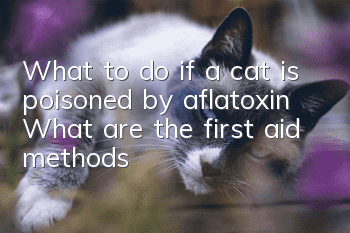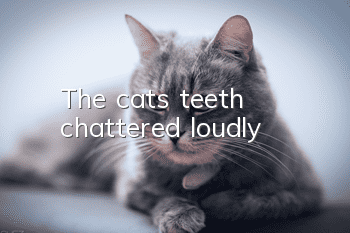What to do if a cat is poisoned by aflatoxin? What are the first aid methods?

Cat
What should I do if a cat is poisoned by aflatoxin? What are the first aid methods? Aflatoxin is a very toxic poison and also contains carcinogenic substances. Among many toxins, It is the most toxic and can easily cause aflatoxin poisoning. Some foods will become moldy due to improper storage, and any moldy food may contain aflatoxin. We should pay special attention to this in the daily feeding and feeding of cats.
Molds tend to grow on grains, oils and their products, and nuts, such as peanuts, cottonseeds, etc., walnuts, almonds, hazelnuts in dried fruits, dairy products, dried salted fish, sea rice, and dried chili peppers. , dried radish strips, etc. Among them, peanuts and their products have the highest aflatoxin content.
After food is contaminated with aflatoxin, under suitable temperature (around 37°C) and humidity (relative humidity of 80% to 85%), aflatoxin will quickly multiply and produce toxin, which is called aflatoxin. Aspergillus toxins. Animal experiments have proven that aflatoxin is a severe liver cancer-causing toxin. Experiments have shown that aflatoxin is a mycomycin produced by Flavosporum. It is one of the strongest chemical carcinogens discovered so far. It mainly damages liver function and has strong carcinogenic, teratogenic and mutagenic effects. It can Causes liver cancer, and can also induce bone cancer, kidney cancer, rectal cancer, breast cancer, ovarian cancer, etc. Aflatoxin has relatively stable chemical properties and can only be destroyed at high temperatures above 280°C. It is not sensitive to heat and cannot be completely removed even at 100°C/20 hours.
1. Pathogenic process:
Initially, AFB1 rapidly accumulates and conjugates with liver cell DNA and proteins, destroying intracellular metabolism, cell renewal, Protein synthesis and fat secretion. GSH depletion in hepatocytes leads to oxidative damage to the cell membrane and loss of intracellular enzymes, including GSH-S-transferase. Cells surrounding the hepatic veins are affected first because this is where the largest number of epoxide-producing CYP450s are found. Eventually, the toxin causes cell lysis and necrosis, and liver cell parenchyma collapses. Structural damage inhibits blood outflow from the hepatic sinusoidal spaces, causing intrahepatic portal hypertension and increased ultrafiltrate (lymph) production in disse lacunae. Increased hepatic lymphopoiesis results in leakage of lymphocytes from the liver capsule into the peritoneal cavity. Acute portal hypertension is accompanied by impaired synthesis of coagulation factors, allowing intestinal red blood cell (RBC) exudative hemorrhage and bleeding. Intestinal bleeding contributes to the development of hepatoencephalopathy, which is consistent with the semi-comatose state of cats in the terminal stages of aflatoxin poisoning. Some cats may develop multiple acquired short circuits in the portal system, confirming the development of portal hypertension.
2. Clinical symptoms:
Low energy, loss of appetite, normal body temperature, and varying degrees of jaundice on the mucous membranes. As the condition progresses, The spirit becomes more depressed and the appetite disappears. Severely ill dogs may vomit blood and have yellowish stains on their abdominal skin, their body temperature drops below 38 degrees, and their feces may appear the color of coal tar, or they may have bloody stools, dark yellow urine, and neurological symptoms such as convulsions before death.
3. Clinical pathology:
Clinical pathology abnormalities are mainly reflected in the following aspects:
(1) Coagulation disorder: activated partial thromboplastin time (aPTT) ), prolonged prothrombin time (PT), decreased fibrinogen concentration, decreased plasma antithrombin activity, protein C and FVII:C - 96%, disseminated intravascular coagulation (secondary to prothrombin and anti- coagulation factor depletion).
(2) Electrolyte imbalance: reflects dehydration, vomiting, diarrhea, abnormal retention or distribution disorder of body fluids.
(3) Hypoalbuminemia.
(4) Liver enzyme activities ranged from mild to significant increases: ALT increased in 83%; AST increased in 79%; ALP increased in 66%; GGT increased in 44%.
(5) Hyperbilirubinemia.
(6) Hypocholesterolemia (71%).
Ultrasound examination may reveal hyperechoic or hypoechoic liver nodules, gallbladder wall thickening and bile duct hyperplasia, mesenteric lymph node enlargement, and some anechoic abdominal exudates. The surface topography of the liver may be abnormal. Some cats develop gastric laxity and are ineffective with gastrointestinal motility promoters. The fine-needle aspiration cytology and histology examination of the liver of the deceased cat were consistent, showing diffuse hepatocyte lipid vacuolization, hepatocyte degeneration and mild inflammatory cell infiltration.
4. Diagnosis:
It is usually necessary to test the aflatoxin content in food to confirm the diagnosis. In terms of clinical pathology, plasma protein C, antithrombin activity and reduced serum cholesterol concentration are the most sensitive biochemical detection indicators in cats with no obvious symptoms, and liver enzyme activity is slightly less sensitive.
5. Treatment:
The affected cat will receive supportive treatment. Cats are treated with sulfhydryl donors (eg, N-acetylcysteine, adenosylmethionine) for 2 months after initial diagnosis. Antiemetics and gastrointestinal mucosal protective agents are given when vomiting occurs. Frozen plasma is transfused in the presence of coagulation disorders. In addition, vitamin K1, vitamin E (≤10IU/kg/d), etc. need to be given.
In order to prevent the production of aflatoxin, when storing grains, oils and other foods, they must be kept at low temperatures, ventilated, dry, and away from direct sunlight. Food should not be packed in plastic bags, and food should not be hoarded as much as possible. Pay attention to food preservation. period, try to consume within the shelf life. In daily life, you can switch to tea tree oil, olive oil and other vegetable oils that are less likely to produce aflatoxin. In addition, do not eat moldy, wrinkled or discolored food. Moldy Chinese medicine contains a large amount of aflatoxin and should not be eaten.
- How to tell if a cat is sick? What are the signs of a cat being sick!
- What should I do if my kitten has eye mucus?
- What can kittens eat besides cat food?
- Do cats produce milk after caesarean section and neutering?
- How do two cats communicate with each other?
- What should I do if my kitten doesn’t like to eat cat food?
- How to feed Birman cats
- Why are cats’ tears red? Pay attention to diet and eye protection
- How to choose a unique name based on the color of your cat?
- Cat with runny nose sneezes and sheds tears



